Mastering the Art of Picture Measurement and Hanging
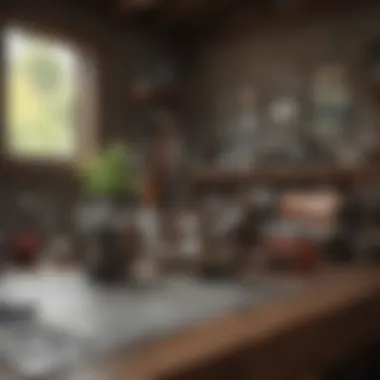

Intro
When you step into a room, the art that decorates its walls can drastically change the vibe. Pictures and artwork add flavor and depth, making a space feel alive. But, hanging these pieces isn't just about sticking nails into the wall. It requires a dash of planning, a sprinkle of precision, and an eye for aesthetics. This guide dives into the nitty-gritty of measuring and hanging pictures, covering the essentials whether you're a homeowner looking to spruce up your living area or a designer striving for a curated look.
Home Design Inspiration
Architectural Styles
Art doesn’t exist in a vacuum; it thrives within the context of its surroundings. When you choose a home design style—be it modern, farmhouse, or eclectic—it's vital to select artwork that complements that aesthetic. For example, a minimalist space with sleek lines and monochrome colors might benefit from a striking, large abstract piece that draws the eye. Alternatively, a traditional home featuring rich textiles may be better suited for classic portraits or landscapes that evoke a sense of nostalgia.
- Contemporary: Think bold colors and modern themes.
- Traditional: Artwork depicting pastoral scenes or classic historical references.
- Industrial: Consider photographs in black and white or visual elements with raw, textured materials.
- Bohemian: Eclectic pieces that blend various styles for a personal touch.
Innovative Decor Trends
As interior design continues to evolve, so do the trends in how art is displayed. Gone are the days when you simply centered a picture over a couch or mantle. Now, it’s all about creating a gallery wall or using unexpected spaces for artwork. Here are a few trends worth noting:
- Gallery Walls: A constellation of images, framed or unframed, that tell a story when grouped together.
- Freestanding Art: Pieces that are not only hung but also placed on shelves or tables for a three-dimensional feel.
- Layering: Placing smaller pieces over larger ones for a dynamic composition.
- Mixing Dimensions: Utilizing various frame sizes and styles to create visual interest on the wall.
Measuring Your Artwork
Tools Required
Before even reaching for a hammer, you need to gather your tools. Essential items include:
- Measuring tape
- Level
- Pencil for marking
- Hammer and appropriate nails or hangers (depending on the weight of your artwork)
The Best Practices for Measurement
- Determine the Height: Generally, the center of the artwork should be at eye level—around 57 to 60 inches from the floor.
- Spacing: Maintain uniform spacing between multiple pieces. A spacing of 2-4 inches usually works well.
- Aligning with Furniture: Use furniture as a guide. For example, you want your art above a sofa to be around 6-12 inches above the back of the sofa.
"Art should speak to you, but the method of hanging it shouldn’t feel like a chore!"
Hanging Techniques
After marking your spots, it’s time to hang. Here’s a simplified process:
- Use a Level: Always check to ensure your artwork is perfectly horizontal.
- Picture Hangers: For heavier pieces, consider wall anchors or picture hooks to maintain stability.
- Nail Placement: Avoid widely spaced nails; they can lead to crooked results.
Incorporating these steps will assure a polished look. This article will continue to explore the aesthetic considerations surrounding art placement, helping you navigate any challenges that may crop up in this process.
Prolusion to Picture Hanging
Hanging pictures may seem like a simple task; however, it goes far beyond just nailing something to a wall. In fact, it’s an art form, intricately tied to the ambiance and character of any space. Understanding the principles of picture hanging can profoundly transform the look and feel of a room. The act of strategically positioning artwork does not only reflect personal taste, it also brings a cohesive flow to the overall design, making it essential in interior design.
The Importance of Art Placement
Art placement is the linchpin in the realm of interior aesthetics. Finding the sweet spot for each piece can dictate how a space resonates with visitors. Think of it this way: a picture hung a bit too high or too low can send mixed signals about the room's design intent. You want your artwork to speak clearly, conveying a message that complements its surroundings.
Consider the following:
- Visual Balance: A well-placed piece can draw the eye and create harmony within the layout of the room.
- Focal Points: Art can serve as bold focal points, guiding the flow and movement within a space.
- Mood Setting: The color palette and style of the art directly influence the atmosphere, whether it be warmth or coolness.
- Personal Touch: Art is a reflection of oneself; its placement allows you to stamp your identity on the space.
Art placements should consider existing decor, room function, and even the emotions evoked by different artworks. If your living area is livened by vibrant abstracts but your bedroom prefers calmscapes, that’s a call for thoughtful arrangement.
"Art, in the end, is about connecting with the viewer; it must not only be seen but felt to impact."
Our exploration into this topic will shed light on these crucial aspects while providing practical guidance. With careful measurement and intentional hanging, anyone can elevate their living spaces from mundane to marvelous. By understanding the nuances of art placement, one can create galleries in their own homes. Whether you are an aficionado or a novice, the knowledge gained here can serve as your blueprint for striking interiors.
Understanding Space and Design
When it comes to hanging pictures, the layout of a room plays a pivotal role. Understanding space and design isn't just about slapping a few nails in the wall; it’s about marrying the art with its environment. A well-placed picture can transform a dull corner into a captivating focal point, while artwork that is misaligned or poorly scaled can create an atmosphere of chaos. The right approach to space and design brings harmony and elevates the aesthetic quality of a room.
Evaluating Room Dimensions
The dimensions of a room dictate much of how we should approach the hanging of art. It’s essential to consider both the height and width of the space. A grand, high ceiling might present opportunities for larger pieces or a gallery wall, while a tighter space might benefit from smaller, framed artworks that don’t overwhelm the area. Take a moment to measure your wall space. Grab a tape measure and jot down important figures. Vertical and horizontal measurements can help you gauge how many pieces can fit beautifully without crowding.
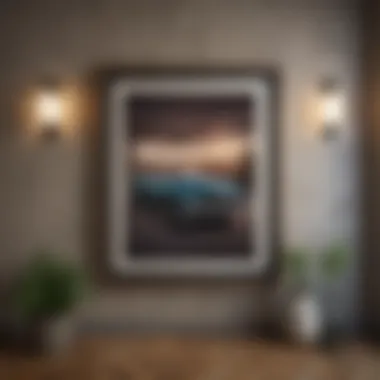
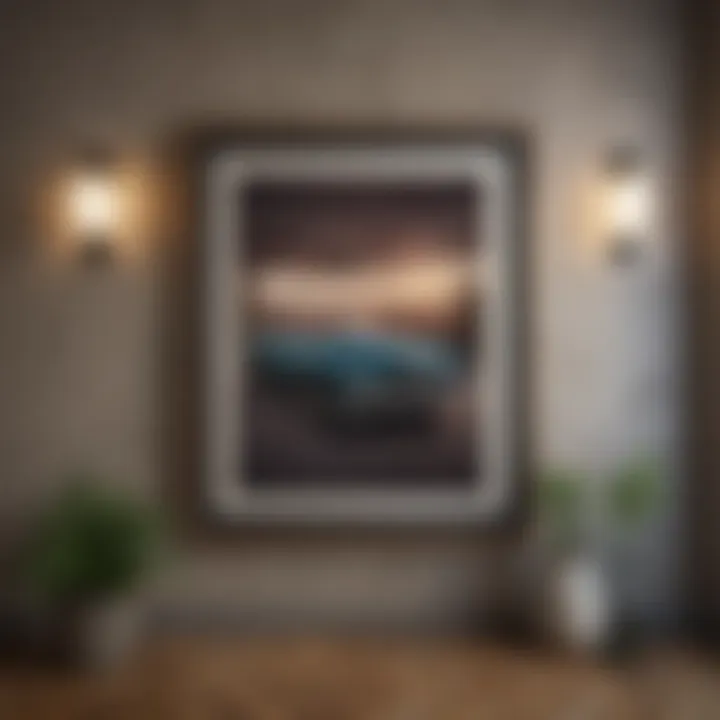
- Key dimensions to consider:
- Height from the floor to the ceiling
- Width of the wall available for art
- Distances from furniture
Having these number figures will assist as you plot where artwork will reside. Moreover, each wall may have a unique personality. A wall behind a sofa might want a singular bold piece, while a hallway can handle a continuous line of smaller framed pictures. Recognizing these dimensions sets a strong foundation for art placement.
Assessing Existing Decor
Before you start hammering away, it’s worth examining the current design elements within the room. The existing decor can influence not just what kind of art to display, but also how it should be arranged. Think of the color palette—art that clashes with the surrounding hues can feel jarring. A well-matched piece can tie the room together beautifully.
To assess existing decor, consider:
- Color Schemes: Match or contrast with the walls, furniture, and accessories. If your room sings in shades of teal, a rich ochre landscape could be a standout addition.
- Textures: Complement or counterbalance different textures like wood, fabric, or metal. A sleek metal frame might heighten the modern feel of an industrial-chic space.
- Style: Is the room minimalist, traditional, or bohemian? The style of your artwork should resonate with the overall theme. A classic portrait might seem out of place in a space filled with contemporary pieces.
"Art should comfort the disturbed and disturb the comfortable." – Cesar A. Cruz
This quote underscores the idea that pieces chosen should not only fill space but reflect a narrative or mood that engages viewers.
By evaluating room dimensions and existing decor thoroughly, you lay the groundwork for a successful picture-hanging experience. It’s about more than just aesthetics; it’s about creating feelings and moods that resonate with those who enter the space. This holistic understanding of space leads to a well-thought-out art display that enhances not just the walls but the overall essence of the home.
Tools and Materials for Hanging
When it comes to showcasing art, the tools and materials selected can truly make or break the final look. Getting the right equipment isn't just about functionality; it's about creating a harmonious aesthetic in your space. Picture hanging may seem straightforward, but the nuances involved can significantly influence the outcome. Choosing the appropriate tools not only ensures that your art is displayed securely, but it also plays a critical role in the ease of the hanging process itself.
Choosing the Right Tools
Selecting the right tools is akin to an artist choosing their brushes—each serves a specific purpose and can impact the final product. You wouldn’t want to hang a large canvas with flimsy hardware, and likewise, a small piece doesn’t require heavy-duty anchors. Here’s a closer look at some essential tools that every picture hanger should have:
- Tape Measure: This is indispensable for determining precise measurements between artworks and walls, helping you establish a centered and balanced presentation.
- Level: Think of it as your visual backup—this ensures that your art isn’t just hanging, but hanging straight. An uneven picture can be an eyesore, deviating from the intended artistic impact.
- Hammer and Nails: These are the basic building blocks of hanging pictures. The kind of nails you use can differ based on the weight of the artwork. For lighter pieces, standard picture nails often do the job, while heavier pieces might call for wall anchors and screws.
- Pencil: Marking the wall lightly ensures that you know exactly where the nail or screw should go without making a mess. It’s an essential yet often overlooked tool.
"A well-planned layout is nothing without the right tools—don’t underestimate the simple pencil!"
The importance of having top-notch tools goes beyond just aesthetics; it enhances precision and safety. You will save yourself a lot of hassle and avoid unsightly marks on the walls or damaged art pieces.
Necessary Hardware
While having the right tools is vital, the hardware is where the magic happens. Different artworks necessitate various types of hardware, and understanding these options can elevate your hanging game to another level. Here’s an overview of essential hardware needed:
- D-Rings and Picture Wire: Often used for heavier frames, the D-ring allows for an adjustable hanging method. Picture wire gives flexibility in positioning, allowing you to easily center a heavier frame without needing multiple hangers.
- Sawtooth Hangers: Best for lighter pictures, these come in various sizes and styles. They facilitate a quick hanging process and can be adjusted slightly for fine-tuning the position.
- Wall Anchors: When it comes to heavier pieces going on drywall or plaster, wall anchors are key. They provide added support and keep your prized possessions secure, thus mitigating the risk of unfortunate mishaps.
- Adhesive Strips: They might not be for everyone, but adhesive strips can save your walls and allow for easy reconfiguration of art. These strips are perfect for renters who want to avoid any potential damage to surfaces.
With a good mix of tools and reliable hardware, you're setting the stage for a beautiful display. Keep in mind that these materials are the backbone of your picture hanging, and investing in quality equipment can yield dividends when creating an inviting and curated space.
Measuring Techniques
Measuring techniques are a vital part of the picture hanging process. Without precise measurements, even the best art may end up poorly positioned, wasting its potential to enhance your space. Proper measurements ensure that each piece of art achieves a harmonious balance with its surroundings, creating a professional appearance. When you take the time to measure accurately, you reduce the chance of errors, which can lead to unnecessary nail holes and a cluttered look.
Establishing a Center Point
To create an aesthetically pleasing display, starting with a well-defined center point is essential. This point serves as the anchor from which all other pieces are aligned. Begin by finding the center of the wall or section where you want to hang your artwork. You can measure the width of the wall and divide that number by two, or use a simple tape method. Place a small piece of painter’s tape or a pencil mark on the wall at the center. This will guide your arrangement moving forward.
- Finding the focal point: The chosen piece should ideally be a standout piece that draws attention. This adds visual interest to your arrangement and allows for more creativity as you choose complementary pieces.
- Measurement for symmetrical arrangements: If you're aiming for symmetry, measure equal distances from the center point to determine where each piece will hang. For instance, if you're hanging two pieces on either side, they should be the same distance from that center point to create balance.
- Consider the scale: When establishing your center point, keep in mind the sizes of the art pieces you are working with. Larger works may need to hang slightly lower to maintain visual weight, while smaller pieces may appear better when centered or higher up.
Determining Optimal Height
Determining the right height for your artwork is a nuanced decision. It plays a significant role in how the pieces are perceived within the space. Generally, the ideal height for hanging art is at eye level, around 57-60 inches from the floor to the center of the piece, as this aligns with the average human line of sight. However, multiple factors can shift this guideline.
- Room function: In spaces where people stand, like a dining room or hallway, a slightly higher position might work well. For areas where one commonly sits, consider lowering the height for a better viewing experience.
- Wall color and texture: Lighter walls can make the artwork feel floaty, while darker walls might absorb some light, so adjust accordingly. If the wall has a unique texture or finish, consider how the picture complements or contrasts with it.
- Furniture and decor placement: Look at what's directly below the art — a sofa or a table, for example — and aim to keep the bottom of your frame about 6-12 inches above these pieces to create a pleasing relationship between them.
"A little thought and care when hanging your art can convert an ordinary wall into an extraordinary gallery."
In summation, mastering the measuring techniques can elevate your art pieces and overall room design. Whether you are an interior design aficionado or simply someone looking to beautify your home, these techniques provide a solid foundation for your picture hanging endeavors.
Creating a Layout Plan
Creating a layout plan is pivotal when hanging pictures, as it lays the foundation for your artistic vision. It’s not just about putting a nail in the wall and hoping for the best; it’s an intricate process that deserves thoughtful consideration. A well-thought-out layout ensures that your artwork doesn’t just fill space, but enhances the overall aesthetic of the room.
A good layout serves several essential purposes:
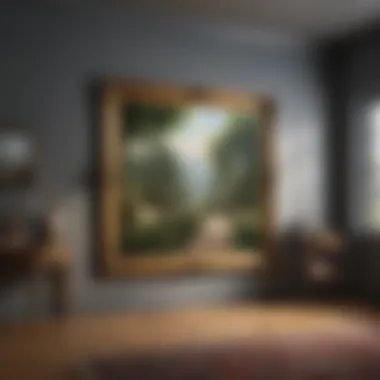
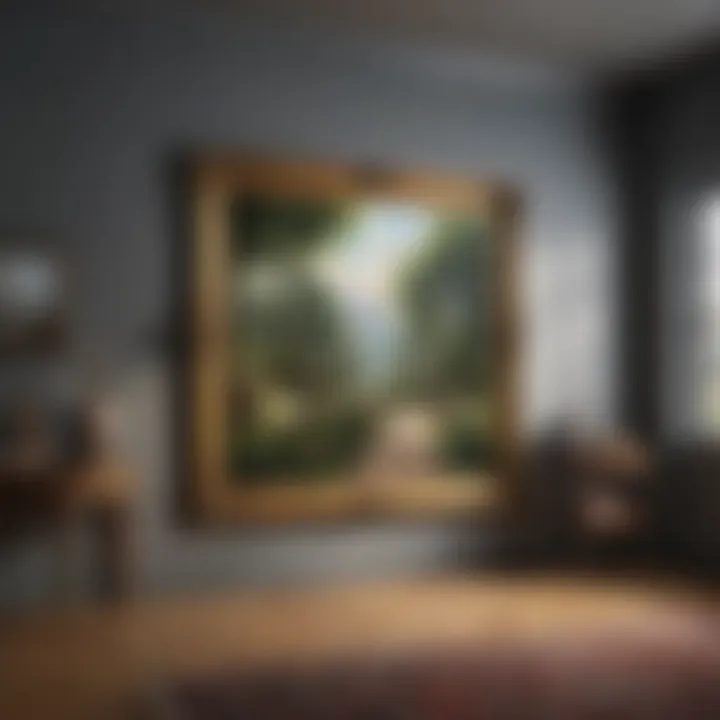
- Cohesion: It helps pieces work together, creating harmony in style, color, and theme.
- Flow: The arrangement dictates how the eyes move through the space, leading viewers to appreciate each piece without distractions.
- Functional Use of Space: It maximizes the utility of wall space without overcrowding or leaving patches bare.
Consideration of the room’s existing decor, as well as personal taste, is vital while crafting this plan. Always remember that each wall can communicate something different, depending on what is placed upon it.
Choosing a Focal Point
Choosing a focal point is like deciding on the main character of a story; it sets the stage for everything that follows. This could be a large painting that captures attention or a collection of smaller pieces grouped together, telling a story. The focal point will draw the viewer's gaze and create a conversational hub within the space.
To determine an effective focal point, ask yourself:
- What piece resonates the most? This can reveal personal stories or profound connections.
- How does this piece relate to the rest of the decor? Ensure that it complements rather than clashes.
The positioning of the focal point is just as significant as its selection. Generally, artwork should be hung at eye level; this makes it accessible and captivating. For larger pieces, say above a sofa or mantle, ensure they are slightly lower so they don’t overpower the space.
Arranging Pictures Effectively
Once the focal point is established, the next crucial step involves arranging the surrounding pictures effectively. A haphazard display can lead to visual chaos rather than a curated gallery feel. There are various arrangements one might consider, including:
- Grid style: Clean, linear arrangements provide uniformity. Ideal for pieces that are similar in size.
- Salon style: This eclectic method utilizes various sizes and orientations, creating a lively, dynamic composition on the wall.
- Linear arrangement: This involves spacing out artworks along a horizontal line with even gaps; it can provide an organized and modern feel.
When arranging pieces, consider the size and shape of both the pictures and the wall space. Using painter’s tape to outline where the edges of the frames will be can help visualize the arrangement before making a commitment. Don’t forget to step back periodically to evaluate how the whole layout resonates. > "The goal is harmony - let each piece converse with the others in a captivating dialogue."
In summary, a well-crafted layout plan integrates these elements to fashion a breathtaking wall display that pleases the eye and resonates with the soul. After all, the artwork isn't just a collection of objects; it's a reflection of your identity and a shaper of your personal space.
Hanging Techniques
Hanging pictures is an art form in its own right, as important as the pieces one chooses to display. Not only can skilled hanging techniques enhance the aesthetic appeal of art, but they also ensure safety, stability, and longevity of the displayed pieces. Understanding the nuances of how and where to hang art effectively can be the difference between a lifeless wall and a captivating, inviting space. Some critical aspects include the proper choice of hardware, appropriate height and spacing, and matching the type of art with the right technique.
Single Picture Hanging
When it comes to hanging a single picture, simplicity is key. This technique embodies clarity in its execution. The first step is pinpointing the height at which you want the artwork to be displayed. A common rule of thumb is to place the center of the picture at eye level, often around 57 to 60 inches from the floor.
To ensure that your picture hangs straight, follow these guidelines:
- Mark the Spot: Use a pencil to lightly mark where the top of the frame will be.
- Choose the Right Hardware: Depending on the weight of your piece, select appropriate hanging hardware. For lighter frames, a simple picture hook will do; heavier pieces may require wall anchors or a metal hanging system that can provide better stability.
- Securely Install: Drive the hardware into the wall, making sure it’s securely fastened. For peace of mind, double-check it with a level.
By keeping the focus on how one picture interacts with the rest of the room, you allow it to stand out in its own right without overwhelming the space.
Gallery Wall Arrangement
Creating a gallery wall is like composing a visual symphony—it requires harmony in layout, color, and size to resonate effectively. This technique allows you to display an array of artwork, photographs, or prints, turning a bland wall into a bustling showcase that captures attention.
Here’s how to tackle a successful gallery wall arrangement:
- Start with a Layout: Before putting holes in your wall, consider laying out the pictures on the floor. This way, it gives you the chance to visualize how everything looks together. You might choose a grid layout for a more formal look or an organic arrangement for a casual feel.
- Vary Sizes and Shapes: Mix and match frames of different sizes and shapes, while sparing attention to color consistency or a common theme among the artworks. This can create a unified appearance while bringing visual excitement.
- Maintain Equal Spacing: When hanging, strive for uniform spacing between each piece. Typically, two to three inches is ideal, but personal preference or the size of the wall may dictate otherwise.
A well-executed gallery wall can tell a story, evoking emotions and connections within the environment.
Bringing all these elements together can transform a simple collection of pictures into a cohesive centerpiece that draws admiration and provides context to your decor. Ensure to step back and evaluate your arrangement from a distance to get a genuine feel for its effectiveness, allowing for adjustments as necessary until it feels just right.
Common Mistakes to Avoid
When it comes to hanging pictures, even the most seasoned decorators can find themselves tripping over the same hurdles. Recognizing the common mistakes people make can save both time and frustration. This section specifically highlights pitfalls to avoid, ensuring your art isn't just on the wall but is displayed thoughtfully and attractively.
Ignoring Scale and Proportion
One of the biggest slip-ups that many make is disregarding scale and proportion. Imagine a vast wall adorned with a tiny 5x7 inch picture—it almost seems like the art is drowning in the expanse. Conversely, a too-large piece can overshadow the room, making it feel cramped. Art should complement, not compete with the space around it.
"Art is not what you see, but what you make others see." — Edward Hopper
To strike the right balance, consider these points:
- Measure Your Space: Before you even think about hanging something, take out that trusty tape measure. Determining the available wall space will help you select artwork that fits within those dimensions.
- Visualize Before You Commit: Use painter’s tape to outline the dimensions of your intended piece on the wall. This gives a clear idea of how it will interact with the space.
- Group Sizes Wisely: If you’re arranging a gallery wall, mix and match sizes thoughtfully. For example, juxtaposing small pieces with a larger centerpiece can create a visual rhythm that is pleasing to the eye.
Failing to Plan Ahead
Planning ahead isn't just for road trips or elaborate dinner parties, it’s vital in picture hanging too. Rushing into it often leads to unnecessary stress and regrettable choices. When you plan, you set the stage for success.
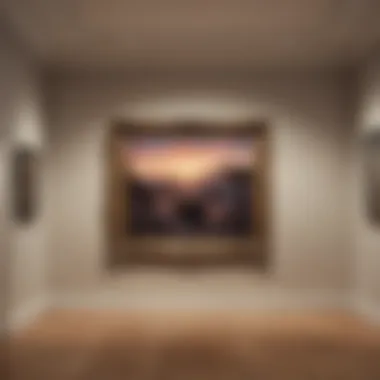

Here are several planning strategies to adopt:
- Storyboarding Your Layout: Sketching out your intended arrangement can be a game changer. It doesn't need to be a masterpiece—just a simple pencil sketch can suffice to visualize the total layout.
- Consider Your Lifestyle: Why place a delicate piece next to a lively play area? Be mindful of the surroundings and how your decor will fit into daily life.
- Sample Display: Before making any permanent changes, try laying out the arrangement on the floor or even using a digital tool. It allows for flexibility and changes without the hassle of nail holes.
Engaging with art should be a gratifying experience. By avoiding common mistakes related to scale and planning, you're not just decorating a space; you're curating an experience.
Adjustments and Final Touches
Getting your pictures hung is only half the battle. The real magic happens when you take a step back and make those last-minute adjustments. This part might seem trivial, yet the tweaks you make can significantly improve the overall effect of the artwork on your walls. Paying attention to details, such as leveling the pictures and adjusting lighting, can showcase your art in its best light and help create a cohesive look throughout the space. Here’s why adjustments are essential.
Leveling Pictures
First off, let’s talk about leveling your pictures. Nothing screams amateur like a crooked frame! Leveling is not merely for aesthetics but also for conveying professionalism. A well-aligned picture grabs attention for the right reasons. Use a simple tool like a level to ensure that your artwork is perfectly straight. If you don’t have a level handy, a smartphone app may do the trick.
One tip:
- Hang the art at eye level, which is generally around 57 to 60 inches from the floor for the center of the piece. This creates a natural engagement with the viewer.
Using a measuring tape before securing a nail can also save you from unnecessary holes in the wall. If your piece isn't aligned right after hanging it, don't hesitate to make minor adjustments to ensure it's perfectly straight. Remember, viewers will notice the details more than you think. So, be meticulous.
Considerations for Lighting
Once your artwork is secured and level, it’s time to think about how lighting can enhance or diminish the appearance of your displays. Proper lighting can transform an ordinary piece into a statement of elegance. Adequate illumination highlights colors, textures, and intricacies, showcasing the art in a way that flatters it.
Things to consider when positioning your lights include:
- Natural Light: Avoid placing artwork in direct sunlight to prevent fading. Watch how shadows may affect the perception of the piece during different times of the day.
- Artificial Lighting: Use fixtures such as track lighting or picture lights that can be directed onto the artwork.
- Ambient vs. Accent Lighting: While ambient lighting sets the overall mood of the room, accent lighting captures attention on your artwork. Layering these can create depth in your space.
"Good lighting can turn a museum exhibit into a dazzling display, enhancing the art's nuances, inviting the viewer's eyes to dance across the canvas."
Making those adjustments and final touches not only enhances the look but also contributes to the overall ambiance of your room. A thoughtful blend of aesthetics and functionality will help you create an artful masterpiece that resonates with all who enter.
Maintenance and Re-evaluation
Taking time for routine maintenance and re-evaluation of your picture placements is crucial to keeping your space looking fresh and well-curated. This aspect often gets overlooked, as many individuals believe that once a photograph or painting is hung, it remains static. However, the dynamics of your living space is always changing, as styles and personal tastes evolve. Engaging with this ongoing process allows for a refined aesthetic that showcases the artwork effectively while honoring any new design instructions you might be embracing.
Routine Checks for Stability
It's vital to periodically check the stability of your hung pictures. This is not just about ensuring that they remain securely in place; it also involves inspecting for any signs of wear and tear in the hardware or the wall itself. You should ask yourself the following questions:
- Is the picture still level?
- Are the hooks, nails, or frames showing any sign of damage?
- Has the weight distribution changed?
Performing these routine checks can save you from future headaches. It’s best to dedicate a small amount of your time to monitor these factors every few months. A picture frame that begins to lean or shift can not only detract from the overall aesthetic but may also lead to unfortunate accidents. In short, treating this process as a preventive method ensures that your decorative efforts maintain their intended impact.
Adapting to New Decor Trends
Keeping pace with current decor trends is another vital component of maintaining your artwork's relevance within your home. As a rule of thumb, it’s advisable to remain attentive to style shifts in the design world. This doesn’t imply that you have to break the bank each time a new trend arises; rather, consider re-evaluating the layout of your existing artworks. Here are a few strategies you might explore:
- Seasonal Rotation: Changing art pieces with the seasons can breathe new life into your space without swapping out all the decor.
- Mix and Match: Embrace the possibility of combining modern prints with classic pieces to create a novel ambiance.
- Consider Wall Color: The hue of your walls could dictate the visual impact of your artwork. A new coat of paint can dramatically alter the mood, encouraging you to experiment with how and what you hang.
The idea is to keep the surroundings interesting and reflective of your evolving personal style. Flexibility in the face of changing trends can enhance your home’s atmosphere and keep your artwork looking its best, resulting in a stimulating and engaging visual experience for both you and anyone who walks through your door.
"A home is not just a place; it's a reflection of who you are. Keeping an eye on what you've displayed helps showcase your journey."
By embracing both maintenance and re-evaluation, you bolster your ability to curate a living space that's as dynamic as you are.
The End
In the realm of interior design, the significance of effectively displaying artwork cannot be overstated. It transforms not just the look of a room, but the entire feel of a space. The art you hang serves as an extension of personal taste, breathing life into the environment. A well-balanced arrangement of pictures does more than decorate; it enhances the mood, cultivates conversations, and often reflects the personality of those who reside there.
The Impact of Well-Displayed Art
Art connects spaces and emotions. When placed thoughtfully, art pieces can become conversation starters, drawing attention and admiration from visitors. The visual narrative created by strategically hanging pictures contributes to a home's identity.
Consider how a carefully curated gallery wall can evolve the atmosphere of a living room. Instead of merely placing pictures randomly, think about how the hues, sizes, and themes resonate together. This act of curation fosters a cohesive aesthetic that can make guests feel welcome while also showcasing your unique style.
- Aesthetic Harmony: Well-displayed art creates visual unity that resonates across a room's elements. When art complements existing decor, it enhances rather than clashes, producing a serene atmosphere.
- Emotional Response: Art evokes feelings. A piece that truly speaks to you can instill comfort or provoke thought, making it significant beyond just a decorative item.
- Spatial Awareness: The way art is hung affects perceptions of space. High ceilings can be accentuated with vertical layouts, while cozy nooks thrive on intimate clusters of smaller art pieces.
Even the lighting can play a crucial role in how art is perceived. Adjustments here – be it natural sunlight or carefully positioned fixtures – can completely alter the impact of an artwork's colors and textures.
"Art is to a room what the soul is to the body."
Mastering the art of hanging pictures isn't just about hammering nails in the wall; it’s about creating an engaging and inviting habitat that resonates with various aesthetics and personal stories.
Intriguingly, the process is never static. As fashions and personal tastes evolve, so too can art displays. Routine checks for stability and seasonally altering pieces can refresh an environment over time. Investing thought and effort into these aspects can dramatically enhance both functionality and visual appeal of a home. Thus, the impact of well-displayed art extends far beyond walls, weaving itself into the fabric of daily life.







